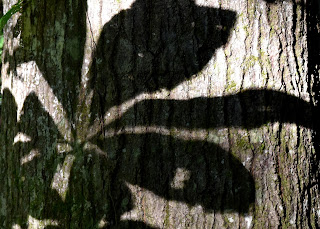I nearly missed the nondescript stalk of white blossoms among the tall greenery beside the forest trail, but I didn't recognize the blooms so I stopped to take a photo. Later it took a little while online but I identified the blossom as ragged fringed orchid. You know, I lived in Ohio for decades without ever knowing that twelve species of orchid grow wild in Ohio's woods, but in the past year I've managed to locate three of them simply by paying attention and remaining curious.
This week my curiosity took me to Boord State Nature Preserve, which I'd never visited even though it's located not far off a route I drive nearly every week. I've read that it's a great place to see early-spring wildflowers, but when I tried to visit in early spring, the access road was under water. This morning, though, I had a relaxing walk through pine woods and along a creek where little was blooming and the waterfall had been reduced to a trickle, but it was a great way to start my week's staycation.
Yes: I've reached important milestones in both my course preparations and my big writing project, so I decided to give myself a week off and see what kind of vacation I can enjoy without sleeping away from home. We'll get the canoe out at some point and find some interesting places to hike, and this weekend we'll get to spend some time with the grandkids, hurrah. The
goal is to have as much fun as possible while socially distancing and
avoiding crowds, which was not a problem this morning because I had the
woods entirely to myself and the only real hazard I faced was the
occasional bit of poison ivy encroaching on the trail. Wouldn't life be
so much easier if the Coronavirus were as easily avoidable as poison
ivy?
 |
| Proof that there are idiots everywhere. |
 |
| Not much of a waterfall this time of year. |
 |
| Ragged fringed orchid. |













